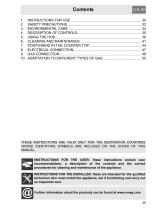
Instructions for the Installer
27
4. Gas connection
If the appliance is installed above an oven, the gas hose must be passed around the back
of the oven to prevent overheating.
The connection to the gas mains may be made using a copper pipe or a continuous-wall
steel hose in accordance with the relevant regulations. To simplify connection, the
horizontal position of the fitting A on the back of the appliance is adjustable. Undo the
hexagonal nut B, turn the fitting A into the required position and re-tighten the hexagonal
nut B (it has a rubber gasket to ensure it provides an effective seal). When installation is
complete, check for any leaks with a soapy solution, never with a naked light. The
appliance is tested with G20 (2H) natural gas at the pressure of 20 mbar. For use with
other types of gas, see point "5. ADAPTING TO DIFFERENT TYPES OF GAS". The gas
intake connection has an external ½” gas thread (ISO 228-1).
Connection with copper pipe: The connection to the gas
supply mains must be made so that no stresses or strains
of any kind are applied to the appliance. The connection
can be made using the adapter unit D with two conical
elements, always fitting the gasket C supplied.
Connection with steel hose: use only continuous-wall
stainless steel hoses compliant with the relevant
regulations, and always fit the gasket C supplied between
the fitting A and the hose E.
When connecting with a hose, ensure that the total length of the pipeline is not more
than 2 metres; also ensure that the hoses do not touch moving parts and are not
crushed.
4.1 Bottled gas connection
Use a pressure regulator and make the connection to the gas cylinder in accordance
with the relevant regulations. Make sure that the gas supply pressure is as stated in
the table in point "5.2 Adjusting for bottled gas".
4.2 Room ventilation
The appliance may only be installed in a permanently ventilated room as specified by
the relevant regulations. The air flow into the room where the appliance is installed
must be sufficient for proper gas combustion and room ventilation. The air intakes,
protected by gratings, must be of suitable size (see relevant regulations) and located
so that they cannot be even partially obstructed.
The kitchen must be kept properly ventilated to disperse the heat and humidity
produced by cooking processes: in particular, a window should be opened or the
speed of any fans increased after prolonged use.
4.3 Combustion gas discharge
Combustion gases must be discharged by means of hoods connected to a flue with
reliable natural draught, or a fan extraction system. An effective extraction system
requires careful design by an authorised specialist, and must comply with the
regulation distances and positions. After installation, the engineer must issue a
certificate of compliance.


















